Think of a mountain range used by the Giro and the Alps surely come to mind. The Apennines are the poorer cousins and all the more interesting for it. This central ridge, the spine of Italy, includes many good climbs and the Blockhaus is one of the hardest on Italy, not just in the Apennines but as challenging as anything in the Alps. The stats are comparable to Mont Ventoux, the reality is even more of a challenge.
This post was first put online in 2017 ahead of the Giro’s visit, it’s been updated for the 2022 return.
The Route: there are three main ways up. This is the climb from Roccamorice on the SP64, KM12 on the profile above and the same route that the Giro d’Italia uses for 2017 and 2022. Roccamorice is in the province of Pescara, Abruzzo, central Italy. The climb is 19km long and averages 8.3%. It’s a remote road but there are signposts all the way. Note the Giro d’Italia calls the climb “Blockhaus” but it stops several kilometres short of this route, the finish is really at Majelletta.
The Feel: Roccamorice sits on a ridge between two small river gorges meaning you have to climb just to reach this town and the start of the climb. It’s a small place but there’s room for parking and a couple of shops and a bakery in case you’ve forgotten any food or need supplies on your return. The town is built with the white limestone of the Majella mountain you’re about to climb.
The start is innocuous, it’s signposted but doesn’t have the obvious visual clues that mark the start of a typical Alpine climb such as a bridge or a valley wall looming above. This is the first challenge and a clue of what is to come: you are never quite sure what lies ahead. Is this one of the hardest climbs in Europe or just a road that heads out to some fields behind the town? For all the fearsome reputation the start is gentle and unremarkable, as it passes chestnut and oak trees. There’s even a football field, proof the terrain is far from vertical.
Things toughen up after 2.5km, the road abruptly pitches up at 7%. This is a small road with a rough surface and you spend time thinking about your line around the cracks and holes. It’s also hard to get into a rhythm because the slope keeps changing. Blockhaus may evoke thoughts of German engineering, of a military road with an regular gradient like the Colle delle Finestre but this has the feel of an old mule path that eventually got tarmacked. It’s not on the profile but the road even descends for a moment early on, a relief for a few seconds but it only means the upcoming road will pitch up even steeper to achieve the 10% average. You’ll find 12-14% along the way.
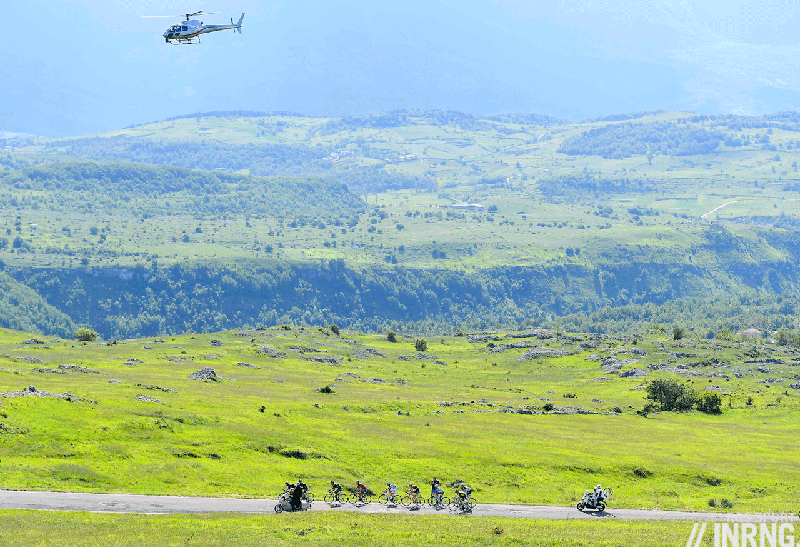
Soon after the trees give way and you’re riding up a big open space. Many mountain climbs can have an obvious feel, as if there was only one place to build the road and you ascend with a rocky flank on one side and pine trees on the other. Here though it’s wide open with not even a tree for company, there are long stretches where you’re the tallest object on the landscape for a long time amid large grassy pastures with thousands of crickets chirping. There are bends along the way to aim for only they’re not the usual hairpins that let you stretch your legs, they’re wide and steep and link some of the hardest sections.
After a series of bends the road tracks up the side of the valley and the road closes in and you pass by some small pines. Progress is slow with the gradient often exceeding 10%. Finally some buildings come into sight, this is the small Majelletta ski station and you come to a T-Junction. Turn right for the Blockhaus (left to descend to thePasso Lanciano and the plains below). You’re now on a much bigger road and it has a touch of Mont Ventoux about it, the white limestone rocks around you and best of all, the enormous views to your left. It’s here where the Giro’s finish line is to be found but only because of logistics and the need to park plenty of trucks around the finish line and whisper it the Giro’s finish isn’t anywhere near the Blockhaus. It’s important to know this if you want to ride on because there’s still another five kilometres to go. Press on? Yes because the views get even better and because you can’t climb here and abandon before the summit, the best is yet to come. Keep going and you get a series of bends past communications masts. The road stops officially but the tarmac continues as a service road for the ski lifts and you can ride on to reach 2,000m above sea level. The road ends short of the Blockhaus, the stone ruins are hardly worth seeing but you can take in the views instead but wrap up because it can be windy and the views of the beaches below contrast with the chill at the top.
The Verdict: 18km at 8.2% sounds hard enough, comparable to Mont Ventoux and there are more similarities thanks to the limestone rocks, communications masts and stunning views. Only this is a much tougher climb. Where Mont Ventoux steep in the forest on a wide, regular road this is irregular in gradient, often steeper than 10% and all on rough rural back road that is much slower to ride and has you changing gear a lot, or at least if you’re lucky to have fitted low enough ratios to cope with the gradient and the relentless length.
It’s remote, there is a ski station but it’s more a couple of sheds connected by a button lift than a resort. It’s remote, a a road up a mountain rather than pass connecting two valleys and you’re more likely to meet deer, boar, foxes and chamois on the way up than other cyclists or motorists, especially on the section from Roccamorice to the Majelletta T-junction. If you’re unlucky you might even meet the bears and wolves that roam here. The climb’s remote aspect probably explains its lack of status, an unknown and unloved king of a climb.
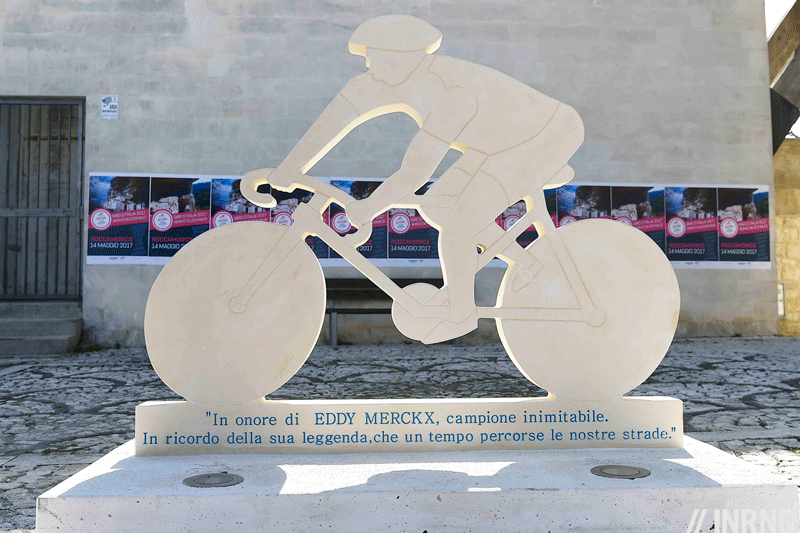
The Giro: 2017 was the Giro’s sixth visit and marked the 50th anniversary of its inclusion. In 1967 and Eddy Merckx won, “of course” you might say but this was a significant moment, his first stage win in the Giro on his way to ninth place overall. This was a surprise win, famously one newspaper headline the next day was “Un velocista belga supera i nostri scalatori“, or “Belgian sprinter beats our climbers” as Merckx had yet to become the fearsome stage racer. Today there’s a memorial to Merckx in Roccamorice, the “unbeatable champion” who “once raced on our roads”.
The race returned in 1968 (Bitossi), 1972 (Fuente), 1984 (Argentin), 2009 (Garzelli) but all on the relatively gentler slopes via Fara Filorum Petri or Lettomanopello: the Passio Lanciano more than the Blockhaus with a bigger road and more level gradients although both still hard work.
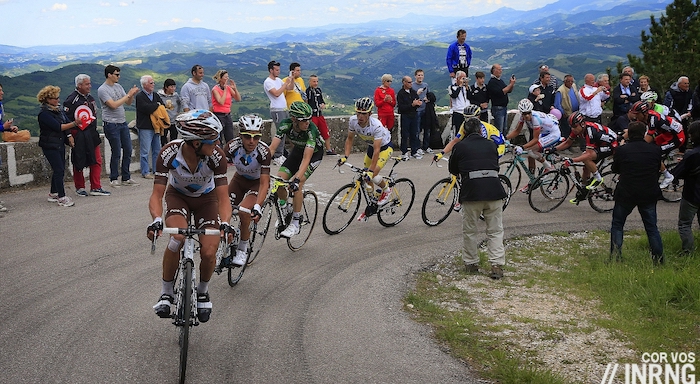
It’ll never happen but imagine for a moment a Giro without the Alps. This may sound sparse and boring but instead the Apennines offer so much climbing that the route would never be short of mountain stages. What the Apennines lack in altitude they supply in attitude, think rough roads, irregular gradients and a dash of mystique, a voyage into the unknown where the peloton doesn’t know what lies around the next hairpin. But these hills lack ski resorts and their money meaning the regions can neither pay for the race, nor host the caravan. At best one day the formulaic pattern of the final Alpine week could be broken.
The Name: blockhaus doesn’t sound very Italian but remember that Italy has only recently started speaking Italian. Back in the 1860s it was common for many military officers to have links to the Hapsburgs and the Austro-Hungarian. The block house was a small garrison designed to allow the army to control the Abruzzo hills for military and economic reasons, a strategic point to monitor the land and any smugglers. One visit to the top and you can see the view for yourself and why the government wanted to control the terrain from this point. The Giro says Blockhaus but the roadsigns in the region say Block Haus.
Travel and Access: it’s a long way from major transport hubs, a problem to get there but it means rewarding roads once you arrive. Rome is the closest city in a straight line but that means crossing the Apennines but there’s the A25 Autostrada. The eastern, Adriatic coast is well served by Autostrade and rail.
- Photo credit: RaBoe/Wikipedia
More roads to ride at inrng.com/roads

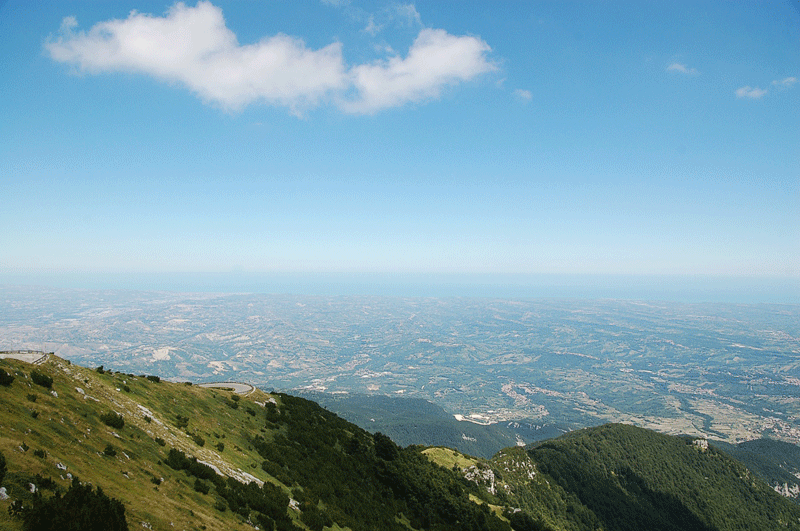
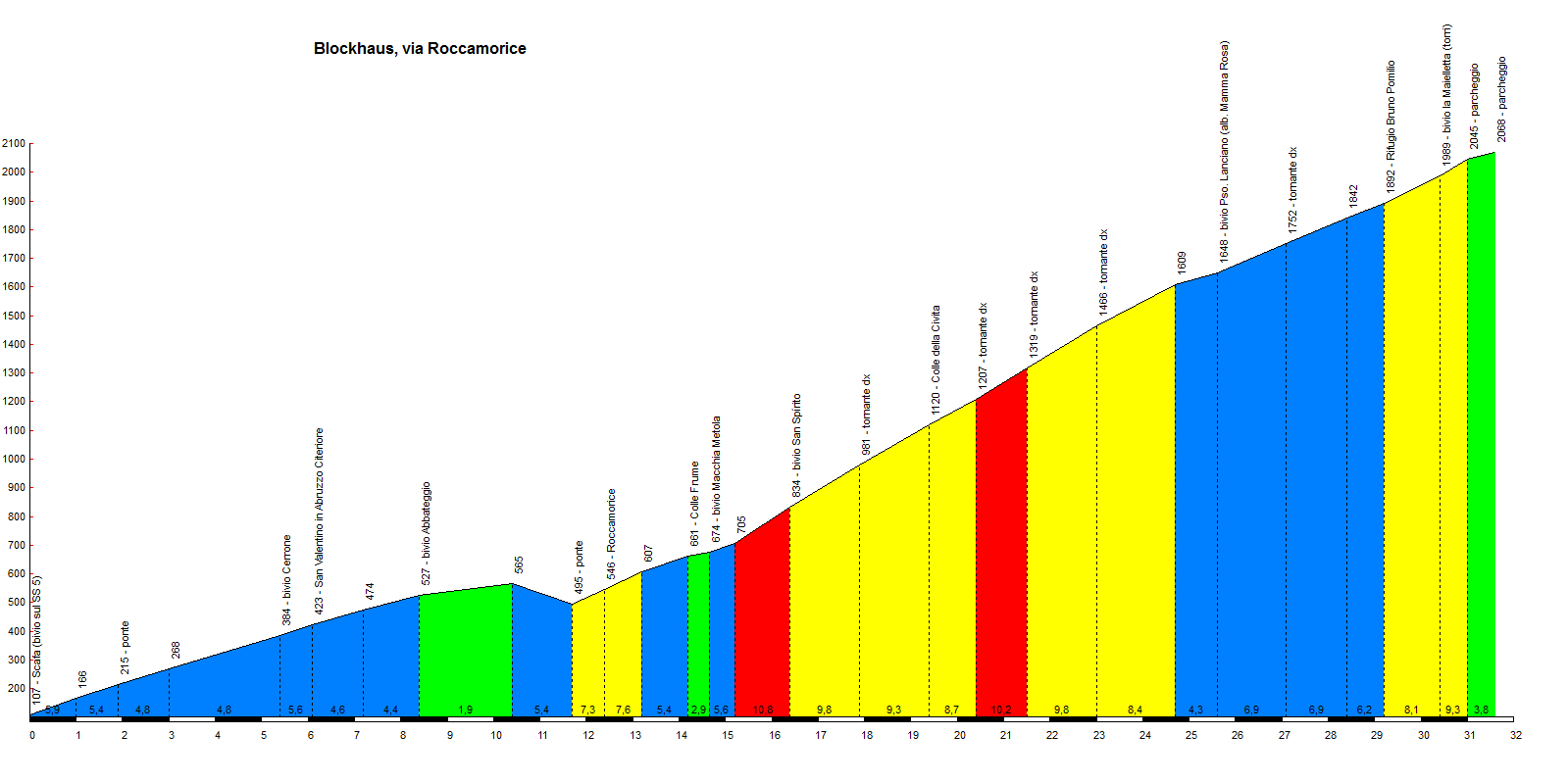
Excellent piece! A climb I’ve yet to “enjoy” but your description reminds me of what a lot of our clients discover on our Legendary Climbs of the Giro d’Italia tour – the uneven grades compared to most climbs in LeTour surprise them – and then they understand why our bike prep sheet says “Fit the lowest gear ratio you can. Nobody has ever regretted this while plenty of regretted not taking our advice.”
Vai Nibali! W Il Giro!
Really looking forward to an excellent day’s racing tomorrow. The Giro will definitely come alive on these slopes. The sprinters have had their time. Many of them will have already booked their flights home. It will be the opening gambit by many of the GC favourites. Although he likes to wait later to attack in grand tours, I expect Quintana to take the victory tomorrow. He will want to stamp his authority and send a message to his rivals and also to Froome. If he gets a good lead tomorrow then he can simply ride defensively for the remaining stages and, in theory, save some energy for the tour.
Another interesting scenario I’m looking forward to is the battle between Landa and Thomas. After Landa’s spontaneous attack today, which Brailsford played down, I expect Thomas to have his tail up tomorrow and send a message to his rogue compatriot. The winner between these two will seal the team leader conundrum.
I’m not sure it will settle anything. Landa could well take time out of Thomas but lose it all again on Tuesday. I think we will have to wait a little longer for that contest to play out.
An interesting piece. I’ve seen other commentators comparing the Giro 2017 Blockhaus climb with Alpe d’Huez in terms of difficulty and length. I await the stage with bated breath.
The stats do stack up in terms of length and gradient but the feel doesn’t, I’d ride Alpe d’Huez any day, or rather it’s so much easier with its smooth road and engineered hairpins to let the coachloads of skiiers get up there. This is a much wilder climb, the gradient keeps changing and the road surface is rough (unless they’ve resurfaced it for the Giro).
Alpe d’Huez’s smooth pavement, wide hairpins and steady incline makes it a lot easyer than the assent, length and gradient indicates compared to any of the Appenine clims.
Last summer i had planned to do both Blockhaus and Campo Imperetore on my packpack tour from Bologna to Reggio Calabira – unfortunately i didn’t ride either.
Imperetore due to heavy thunderstorms so i divereted when i reached Amatrice and rode arround via l’Aquila. Blockhaus because i suffered from bad stummach and temprature was ridicuously hot – plan was to do the Roccamorice climb (seemed to be the most beautifull on the map) – instead i rode arround Maiella via Manopello, Roccamontepiano and Pretoro.
I have to go back, those big central and south Appenine climbs are are unebeliveable beautiful.
Thanks, enjoyed that.
Thanks for a great review of one of my favourite climbs, among those I could ride, at least.
Those central 7.5 km averaging 9.8%, irregular as for gradient peaks but at the same time barely allowing any serious rest, are really something that goes beyond the hard section of the Ventoux, not to speak of Alpe d’Huez or Hautacam, and, wasn’t it for altitude, way worst than the Galibier’s over 2000 finale.
A very different climb in look and feel, but speaking of abstract difficulty it is up there with Marmolada (Passo Fedaia).
It’s a pity they don’t reach the top, but they rarely did, anyway. And they always called it Blockhaus, I must say… branding was rampage fifty years ago, too.
The different variants of the climb were a regular presence between 1967, when it was “discovered” and 1973: 6 times out of 7 edition. Then it appeared just a couple of times in the following 30 years, whereas since 2006 it’s been included three times in 12 editions.
By the way, in 1967 they arrived at the top but it wasn’t Roccamorice, they were tackling the easier Pretoro variant (same as Fara Filiorum Petri but with a slightly different beginning).
The climb was a success, they used it the following year, too, as the last stage before the final parade… in Naples (a Giro ending in Southern Italy): Bitossi won, Merckx was already dominating that Giro.
This first two cases were the only ones when the race climbed up to the “true” Blockhaus, and they both used the easier side.
Note that in 2009, for the 100-years Giro, the race ended in Rome, and the harder mountain stages were all on the Appennini, as inrng suggests in the post above. And (an easy) Blockhaus was included.
In 1969 they tried for the first time the Roccamorice harder version, but it wasn’t an uphill finish, thus they just arrived at the junction and thn down to Pretoro through Passo Lanciano. The climb was halfway through the stage before some 90 flat kms and it was stage 12th. Several in-form gregari could stay with the captains and a handful of them crossed the line some secs ahead of the selected group, bringing home a rather unexpected maglia rosa and a stage win (both riders, Colombo and Schiavon, were in great form).
1970 had a carbon copy of the 1969 concept and even less selection. The stage was decided by solo attacks from the top riders’ group in the last flattish 30 kms.
Perhaps unsatisfied by these results, after one year’s “exclusion”, the organisers went back to the Pretoro side in 1972 with a brutal morning “semitappa” of 48 kms and an uphill finish, before the afternoon long sprinter stage to Foggia. Fuente destroyed the field, with only his teammate Lasa less than 2′ back at 1’36”. Motta was third at 2’36”, tracked by Merckx. Merckx had to fix that embarassing situation with the famous attack in Calabria, when he mad an early break with Pettersson and went all the way to the line leaving the whole bunch more than 4′ back.
In 1973 the harder Roccamorice side featured for the last time. Like in 1969 and in 1970, it wasn’t an uphill finish, but this time the finale was a bit closer, some 50 kms from the hill top. Fuente attacked hard but Merckx was able to get him and beat him on the line. More or less everyone else (except Panizza) couldn’t come back closer than 2′. The riders protested against the inhumane climb many of them had to walk up pushing their bikes, and the Giro didn’t visit until ten years later. Not the Roccamorice side anymore, ever… until tomorrow. Many of them were already racing in 1969 and 1970, but the attitude apparently made all the difference of this world.
Later appearance were:
1984, 5th stage, uphill “low altitude” finish, easier Pretoro side: Argentin won over Moser, top 20 riders split by seconds in a 90″ total time difference;
1992, 6th stage, for the first time the Lettomanoppello side was used (hard but with homogenous gradient) as the first climb in a series of three to end a 223 km long Appennini stage. Indurain already had nearly a minute over the rivals, after an attack on the hilly stage 3 and the ITT: Chiappucci attacked him on the Majelletta without much effect. The main news of day was Fignon dropping out of GC.
2006 used the same 1992 Lettomanoppello side as an early uphill finish and Basso destroyed the competition.
Finally, 2009 went back to the easy Fara Filiorum Petri (Pretoro) side, with what could be considered as a sophisticated quotation of the 1972 “semitappa”: just 84 kms (this time it wasn’t a “semitappa”, just a “normal” stage, albeit very short). The violent effort became someway similar to an uphill ITT. Pelizzotti dominated, while nearly one minute back Di Luca and Menchov were duelling, with… Garzelli taking the spoils. Basso was a few secs back, than at a further minute Rogers, Armstrong, Sastre and Leipheimer crossed the line together.
PS Thanks to ilciclismo.it for providing a lot of stage profiles from old Giri and to bikeraceinfo.com for a lot of stage results. The 1992 stage enjoyed a detailed full page report on the Spanish press, from whose archives I recovered the story.
Great history and information on the climbing approaches, I tried to find this but couldn’t so could only approximate that because Roccamorice is getting a Merckx monument he went via there.
2009 is the reference for a race without so many Alpine climbs. The Pergola to Monte Petrano Stage 16 was perhaps too long to repeat again and again – 237km – but an Apennine classic with the Acqualagna gorge, then Monte Nerone, Monte Catria and then Monte Petrano.
Yes, the rest of the 2009 last week was a bit weak with both the Vesuvio and the Blockhaus being essentially monoclimb in very short or relatively short stages, but the M.te Petrano stage was a masterpiece, along with many other in that Giro, say, the Cinque Terre ITT, the scenic Roma finale or the whole Emilia Romagna weekend. It had flaws – generally too “easy” for a Giro, maybe – and epic fails, too (the fake “Cuneo-Pinerolo”, the Milano circuit), but all in all I liked it.
Back to tomorrow’s mountain, I can’t avoid recalling that one of the most memorable action on the “Blockhaus/Passo Lanciano” didn’t happen at the Giro… I’m thinking about the Guardiagrele stage with Contador’s attack on the Lettomanoppello side during the 2014 Tirreno-Adriatico.
And, regarding Merckx, you may have listened – several times – these days on Italian TV that old yet always fun story about the press anger and dismissal of both the climb and the Belgian (then still an unknown quantity) after that 1967 victory: “The Italian climbers Zilioli and Motta beaten by a sprinter, not selective enough as a climb if a ‘velocista’ can win there”. The sprinter was obviously Merckx.
2009 was Pellizotti, not Garzelli.
I guess it’s about re-written results due to doping facts. But that’s a stage which most readers may remember – as I reported it above, I think.
According to Daniel Friebe in Mountain High Pellizoti and 3rd placed finisher on that day, Danilo di Luca were disqualified almost 2 years later giving the victory belatedly to Stefano Garzelli
Indeed, thank you: I remembered something along those lines even if I couldn’t remember when it happened and because of what specific investigations or infractions.
However, what I mean (and perhaps the reason why inrng wrote “Pellizotti”) is that to better understand the climb or what happened that day you need to remember the race or, at least, to look at the classification *determined by the road*.
Doping sanctions are just that… sanctions: a punishment for the rider, but it obviously makes little sporting sense – or none at all.
I’m not going to debate if changing the results even makes sense *as a sanction* or not (sometimes I’m favourable, sometimes it’s pretty laughable, so it’s hard to have a general, consistent position).
What’s pretty much sure is that rewritten classifications don’t give much hints about how a climb or a race really “worked”.
If anything, we might think (but this is admittedly pub-style small talk) that very short and/or monoclimb stages (like ITTs) may be an interesting doping thermometer since they’are about reaching max power in a controlled environment and time setting, which is more easily affected by doping than other aspects of the discipline (tactics, complex effort distribution, resilience etc.), thus producing a shift in relative performances when compared to other riders. Even if it was “true”, it would be far from being a deterministic thing, that is, even on such a terrain you can perform great thanks to your natural skills – yet doping would perhaps be more useful in these circumstances.
One of the times the comments are as good as the piece! BRAVI to all – this is what makes this the best forum I’ve seen in terms of knowledge, sharing and freedom (mostly) from nasty attacks on other comments.
On Travel and Access, an option is to fly direct to Pescara. From there, the (itself scenic) trainline inland to Sulmona – via Chieti and Popoli – would offer several starting points for Maiella.
Great post, thanks for this!
Thanks to everyone for their contributions, it’s quite hard to find much information about this brilliant part of the world. I am lucky enough to have a little house near Chieti and have had a personal battle with the Blockhaus climbs! The first time one August it was way too hot and I was nowhere near strong enough, so I had to settle for Passo Lanciano. The second time was October and I got beyond Mamma Rosa and in sight of the aerials, but the road was covered in frozen snow and ice so there was no way of making it to the top. Last summer I drove to Mamma Rosa, descended to Roccamorice and then did the whole climb. It felt like 10 km or so were exposed with the sun beating down, if there had been any wind it would have been impossible. There is a tree-lined section about 2-3 km from the t junction at Mamma Rosa, but it takes so long to get there you don’t have much left.
There are actually 3 possible ascents; 1) from Fara Filiorum through Pretoro and Passo Lanciano, definitely the easiest. 2) From Lettomanopello through Passo Lanciano and then to the summit. 3) From Roccamorice you meet the other road at Mamma Rosa. Which is the hardest? I have to confess when I did the route from Lettomanopello, I stopped at Passo. I had already climbed over 2000 feet by the time I got to Letto and didn’t think I’d have the legs to go all the way, so hopefully this summer and will do the two hard ones properly and know which is harder.
I rode the second half of 2017’s Stage 9 on Sunday, a few hours ahead of the pros. I’d done a 100 km and 1300 m of climbing the day before, which is what I would call an average weekend ride. I would normally have a day off after that, not attempt a climb as hard as the Blockhaus with an 80 km ride to get there!
This summer I plan on climbing the Stelvio, looking forward to the comparison!
Been thinking about this, is it rare for a mountain to be open and exposed at the bottom, and then have tress nearer the top? You do then go out into a wonderfully open exposed part once past the ski station, but certainly on Sunday the heat contributed to my own struggles with the climb.
Yes, rare for the top of a climb to be wooded and the start exposed but you can find some, for example the Joux Plane has more fields at the start and then a wooded section higher up but even Blockhaus doesn’t have many trees around the top.
Always enjoy reading these pieces again when the Giro revisits a particular mountain. A slight typo – “It’s remote, a a road up a mountain rather than pass connecting two valleys”. Feel free to zap this comment.
thank you for another nice review!
wouldn’t “campione inimitabile” mean unique, rather than unbeatable? (one who cannot be imitated)
With the steep gradients and wind yesterday, it looked a thoroughly unenjoyable climb!
A hell of a climb, indeed, and if there was no wind you may suffer because of the heat. But the sceneries was great, it allows very nice “parallax” heli shots of the narrow roads snaking up throw pastures and rocks with high snowy mountains in the background.